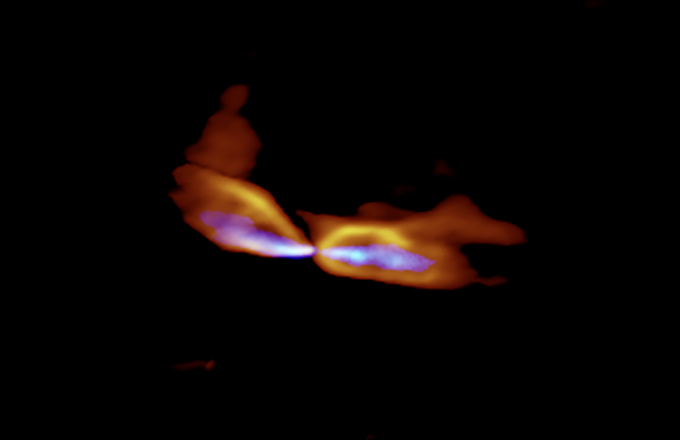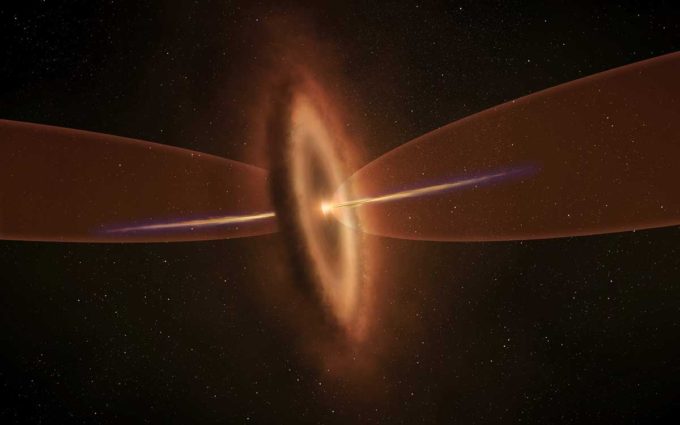ALMA Differentiates Two Birth Cries from a Single Star
Astronomers have unveiled the enigmatic origins of two different gas streams from a baby star. Using ALMA, they found that the slow outflow and the high speed jet from a protostar have misaligned axes and that the former started to be ejected earlier than the latter. The origins of these two flows have been a mystery, but these observations provide telltale signs that these two streams were launched from different parts of the disk around the protostar.
Stars in the Universe have a wide range of masses, ranging from hundreds of times the mass of the Sun to less than a tenth of that of the Sun. To understand the origin of this variety, astronomers study the formation process of the stars, that is the aggregation of cosmic gas and dust.
Baby stars collect the gas with their gravitational pull, however, some of the material is ejected by the protostars. This ejected material forms a stellar birth cry which provides clues to understand the process of mass accumulation.
Yuko Matsushita, a graduate student at Kyushu University and her team used ALMA to observe the detailed structure of the birth cry from the baby star MMS5/OMC-3 and found two different gaseous flows: a slow outflow and a fast jet. There have been a handful of examples with two flows seen in radio waves, but MMS5/OMC-3 is exceptional.
“Measuring the Doppler shift of the radio waves, we can estimate the speed and lifetime of the gas flows,” said Matsushita, the lead author of the research paper that appeared in the Astrophysical Journal. “We found that the jet and outflow were launched 500 years and 1300 years ago, respectively. These gas streams are quite young.”
More interestingly, the team found that the axes of the two flows are misaligned by 17 degrees. The axis of the flows can be changed over long time periods due to the precession of the central star. But in this case, considering the extreme youth of the gas streams, researchers concluded that the misalignment is not due to precession but is related to the launching process.
There are two competing models for the formation mechanism of the protostellar outflows and jets. Some researchers assume that the two streams are formed independently in different parts of the gas disk around the central baby star, while others propose that the collocated jet is formed first, then it entrains the surrounding material to form the slower outflows. Despite extensive research, astronomers had not yet reached a conclusive answer.
A misalignment in the two flows could occur in the ‘independent model,’ but is difficult in the ‘entrainment model.’ Moreover, the team found that the outflow was ejected considerably earlier than the jet. This clearly backs the ‘independent model.’
“The observation well matches the result of my simulation,” said Masahiro Machida, a professor at Kyushu University. A decade ago, he performed pioneering simulation studies using a supercomputer operated by the National Astronomical Observatory of Japan. In the simulation, the wide-angle outflow is ejected from the outer area of the gaseous disk around a prototar, while the collimated jet is launched independently from the inner area of the disk. Machida continues, “An observed misalignment between the two gas streams may indicate that the disk around the protostar is warped.”
“ALMA’s high sensitivity and high angular resolution will enable us to find more and more young, energetic outflow-and-jet-systems like MMS 5/OMC-3,” said Satoko Takahashi, an astronomer at the National Astronomical Observatory of Japan and the Joint ALMA Observatory and co-author of the paper. “They will provide clues to understand the driving mechanisms of outflows and jets. Moreover studying such objects will also tell us how the mass accretion and ejection processes work at the earliest stage of star formation.”
Additional Information
These observation results were published as Matsushita et al. “Very Compact Extremely High Velocity Flow toward MMS 5 / OMC-3 Revealed with ALMA” in the Astrophysical Journal issued in February 2019.
The research team members are:
Yuko Matsushita (Kyushu University), Satoko Takahashi (Joint ALMA Observatory/National Astronomical Observatory of Japan/SOKENDAI), Masahiro Machida (Kyushu University), and Koji Tomisaka (National Astronomical Observatory of Japan/SOKENDAI)
This research was supported by JSPS KAKENHI (No. 17K05387, 17H06360, 17H02869, 15K05032) and the Science Visitor Program of the Joint ALMA Observatory.
El Atacama Large Millimeter/submillimeter Array (ALMA), una instalación astronómica internacional, es una asociación entre el Observatorio Europeo Austral (ESO), la Fundación Nacional de Ciencia de EE. UU. (NSF) y los Institutos Nacionales de Ciencias Naturales de Japón (NINS) en cooperación con la República de Chile. ALMA es financiado por ESO en representación de sus estados miembros, por NSF en cooperación con el Consejo Nacional de Investigaciones de Canadá (NRC) y el Ministerio de Ciencia y Tecnología de Taiwán (MOST), y por NINS en cooperación con la Academia Sinica (AS) de Taiwán y el Instituto de Ciencias Astronómicas y Espaciales de Corea del Sur (KASI).
La construcción y las operaciones de ALMA son conducidas por ESO en nombre de sus estados miembros; por el Observatorio Radioastronómico Nacional (NRAO), gestionado por Associated Universities, Inc. (AUI), en representación de Norteamérica; y por el Observatorio Astronómico Nacional de Japón (NAOJ) en nombre de Asia del Este. El Joint ALMA Observatory (JAO) tiene a su cargo la dirección general y la gestión de la construcción, así como la puesta en marcha y las operaciones de ALMA.
Images

ALMA image of the protostar MMS5/OMC-3. The protostar is located at the center and the gas streams are ejected to the east and west (left and right). The slow outflow is shown in orange and the fast jet is shown in blue. It is obvious that the axes of the outflow and jet are misaligned. Credit: ALMA (ESO/NAOJ/NRAO), Matsushita et al.
Contacts
-
Valeria Foncea
Education and Public Outreach ManagerJoint ALMA Observatory Santiago - ChilePhone: +56 2 2467 6258Cel: +56 9 7587 1963Email: [email protected] -
Masaaki Hiramatsu
Education and Public Outreach Officer, NAOJ Chile -
Charles E. Blue
Public Information OfficerNational Radio Astronomy Observatory Charlottesville, Virginia - USAPhone: +1 434 296 0314Cel: +1 202 236 6324Email: [email protected] -
Calum Turner
ESO Assistant Public Information Officer




